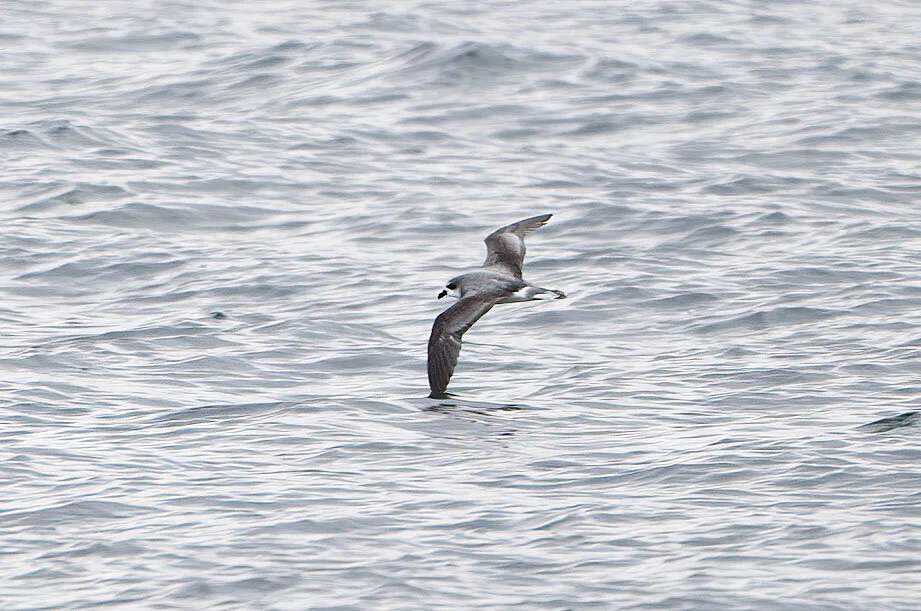Soft-plumaged Petrel at Varanger, Norway, June 2009
In June 2009 Mark Bannister and I observed a Soft-plumaged Petrel off Nesseby, Varanger, Norway, the first record for the North Atlantic Region. This is the account published in Birding World Volume 22 Number 6 Published July 2009
Graham Catley
In June 2009, Mark Bannister and I visited Finnish Lapland and the Varanger area of northern Norway. We flew into Ivalo, Finland, on 4th June and then drove to Varangerbotn, at the head of Varanger Fjord, where we arrived in the late afternoon of 6th June. The evening was dull and cloudy, but there was little wind and the fjord was quite calm, so we decided to take a quick look at Nesseby. It was high tide, so there were few waders in evidence, but a walk out to the shore revealed both Arctic and Long-tailed Skuas chasing Arctic Terns and Kittiwakes, as well as several groups of auks feeding well offshore. As always, I had my Canon SLR and 500mm lens over my shoulder, looking for a nice target. At about 5.30pm, a dark morph Arctic Skua settled on the rocks and was immediately mobbed by two Arctic Terns. It quickly flew, and I tracked it with my camera, taking a few shots as it passed our position. It then dived down to the water and, through my camera, I saw it chasing a smaller grey and white bird that I immediately recognised as a Fea’s-type petrel. I called to Mark, but this was such a shock and so unexpected that I failed to think whether to watch the bird or to try and take some photographs, but the photo bug prevailed and I took a few shots of the petrel as the skua gave chase. After a few seconds, the petrel broke away and dropped briefly to the water. It then flew around a couple of times and then flew off quite slowly eastwards, towards Vadsø. As I had taken 16GB of photographs in two days, I was conserving shots and had my camera on ‘low speed continuous’ shooting mode; as the encounter had been so sudden, I had no chance to change to high-speed mode while the bird was in view, so I ended up with just 17 photographs. I realised how significant the record was and, as the bird disappeared, I hardly dared to look at the images on my camera screen. Quite often the auto-focus system fails when birds are over water but, to my relief, several were apparently sharp, although obviously small in the frame. The pictures were correctly exposed too (I was using manual exposure, as I normally do) but, oddly, the bird appeared to have a complete and quite wide, grey breast-band. That night, a further look at the images and comparison with the plates in Collins Bird Guide (Svensson & Grant 1999) suggested that identification as Fea’s Petrel may not be that certain.
On my return to Britain, I was able to see the images more clearly on my computer screen on 14th June, but I was still unable to make a certain identification, although the breast-band and upperpart pattern appeared to fit Soft-plumaged Petrel Pterodroma mollis rather better than Fea’s or Zino’s Petrels. Although much is written about the modern lack of observation skills and the loss of field descriptions, it is salutary to record that, without the photographs I took of this bird, my description would probably have pointed to the wrong species and, given the bizarre location of the occurrence, might well not have been believed anyway! My thanks to Mark for good company.
Graham Catley, Lincolnshire.
Formerly considered conspecific with Fea’s Petrel and Zino’s Petrel of the northeast Atlantic, Soft plumaged Petrel occurs widely in the South Atlantic, southern Indian Ocean and southwest Pacific, with its population estimated at some tens of thousands of pairs (HBW, del Hoyo et al. 1992), but it does not normally occur north of the Tropic of Capricorn. It has not occurred in the North Atlantic region before – not even off the Pterodroma hotspot of Cape Hatteras (see Birding World 22: 151-161).
As soon as Graham had returned home and viewed his photographs, he kindly sent them to Birding World. Although undeniably a tricky identification, those of our Identification Consultants most experienced with seabirds quickly confirmed that, as unlikely as it seemed, they believed it to be a Soft-plumaged Petrel. Ian Lewington has experience of this species and has kindly commented: ‘In addition to the pro-mollis plumage features shown by the Nesseby bird, Graham Catley’s excellent photographs hint at the less well-proportioned shape of mollis, which has a stockier body and shorter wings compared to the more elegant, sleek bodied, longer winged Fea’s/Zino’s Petrels. Indeed, my illustrations in British Birds 97: 9 (2004) do not totally convey this proportional difference, which is subtly apparent in photographs but most striking in the field.’ The Norwegian Soft-plumaged Petrel is the first for the North Atlantic region and the second for the Western Palearctic (following one seen off Eilat, Israel, on 25th March 1997). Eds.















